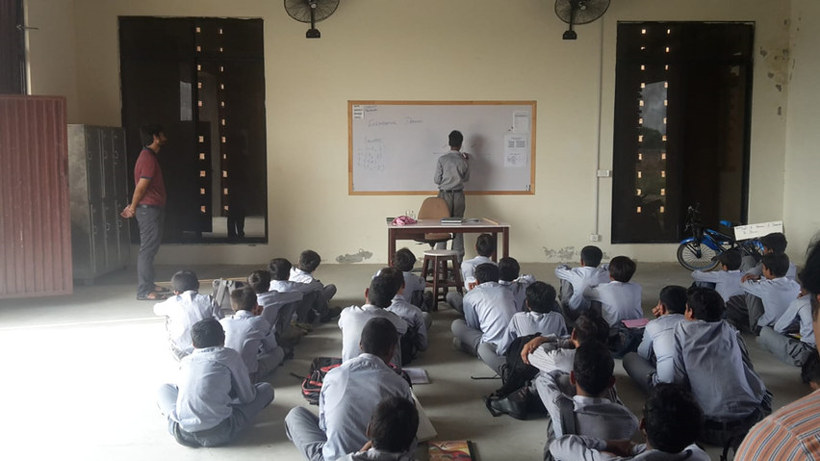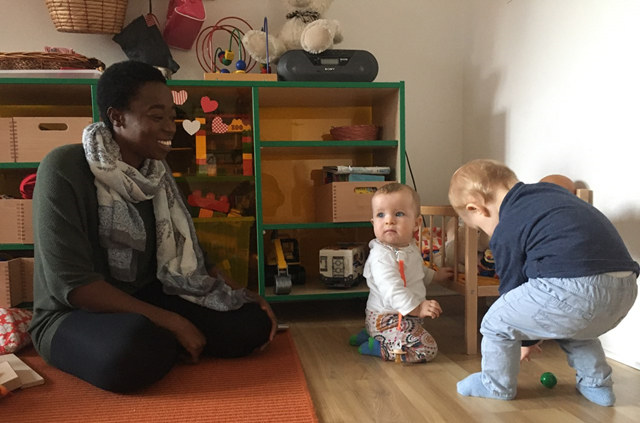Very closely linked to the idea of culture as a map of orientation is the understanding that culture is learned and passed on. In other words, people are socialised into collectives such as a family, an organisation, a sports club or a university study group. When we say that culture is learned, then we are simply negating that culture is something we are born with. In addition, it refers to the fact that we are able to learn through communicating, following and imitating the actions of others. Furthermore, it highlights the fact that the knowledge and behaviour acquired by past generations is made available to future generations. Of course, some of it may get lost, become interpreted in a new light or changed, but it is potentially available and can be tapped into.
Learning culture is also referred to as socialisation. This process starts with childhood and continues throughout our lives. During our childhood years, we learn simple things such as what is perceived to be proper table manners. We also learn to speak the language of our parents, learn what is considered to be polite, whom and what to trust, how to approach people and communicate with them and how to deal with disagreements. And of course during this time some will attend kindergarden, all will go to school, where we acknowledge and learn from our environment.
Task: Teaching and learning
Look at the picture taken at a school in Pakistan. What do you think is similar to your own school and what do you think appears to be different? Note down your thoughts in your learning journal.

Photograph by Anne Goos (used with permission). Not CC licensed
Having completed this task, click on the following link to view a possible answer.
Show / hide sample answer
This is what a German student noted down:
I see a teacher instructing a group of students, one student writing his answer on a whiteboard, books and notebooks near the students. This could be a scene from my own school days.
What is different is that the window shutters right and left from the board are closed may be to keep the sun out, students are sitting on floor, there are no tables, no computers and other equipment. I also observe that all learners are boys or young men and all seem to be wearing the same type of shirt and trousers. Maybe it is a school uniform.
The photograph does not provide any information as to what is being taught and we also do not know how exactly this is done but it does provide indications that formal teaching is a common way of imparting knowledge.
Task: Socialisation across cultures
This is Ernestina (name changed), who grew up in a village in West Africa and came to Germany about five years ago. She is now a trained day care mother and looks after three children. Do you think her upbringing in a village in West Africa and her training as a day care mother influences the way she looks after the children? Note down your thoughts in your learning journal.

Photograph by Elena Busshoff (used with permission). Not CC licensed
Having completed this task, click on the following link to view a possible answer.
Show / hide sample answer
When asked about whether she feels that she trains and educates the children differently, Ernestina said the following:
"In the village where I was born and raised, everybody was expected to look after the children of the village and felt responsible. This is also why all adults were allowed to reprimand children, no matter who the mother was. This is why I feel that all children I take care of here are like my own children, and when they are sick, I carry them around, I console them and feel sorrow. And when they leave I really feel an emotional pain. When I went for training as a day care mother we were told to keep an emotional distance to the children we are looking after. This was new to me and I feel that I cannot follow this advice, it would just not be me. But other than that I follow the script of what I learned during my training and cannot really see a difference between me and my fellow day care mothers."
This is what a mother says about Ernestina:
"I don't know whether it is her upbringing in Africa or just her personality, she is very warm hearted and when I leave my child here, I know it is being taken care of and you can tell that she loves the children here. Ernestina passed her training and I know that she has all the necessary knowledge about hygiene, healthy food and how to train children."
But socialisation does not stop once we have completed our formal education and (possibly) graduated from college or university. It continues for example when we start working in a company. Here it usually takes place in a formal but also an informal way. The formal process may might involve an initial introduction and instruction regarding ‘the way we do things around here’, whereas the informal way will involve activities such as observing behavioural patterns, asking questions or by listening to stories. Socialisation is thus the process of internalising culture and represents the whole process of learning throughout the course of our lives. It has a major influence on our behaviour, beliefs, and actions both as children and as adults.
Cultural learning as a lifelong process is recognised by companies who appreciate and support a learning culture as part of their organisational culture. When this culture is ‘lived’ authentically by a company, it not only promotes the ongoing development of the employee by providing opportunities to acquire new knowledge, but also supports genuine collaboration among employees and beyond. The acknowledgement that the experiences and knowledge that people bring into the company are hugely valuable assets is a key principle for all learning at the company. This also involves enabling people to learn from their mistakes and actively seeking out challenges, thus enhancing creativity and innovation.
The fact that culture and thus behavioural patterns and knowledge are passed on reminds us that cultural repertoires are not created randomly and thus do not simply happen. This holds true for countries as much as for companies and other collectives. Just imagine you wish to work for a small family business. How much will the history of the company influence the way things are done?
Think about IKEA for example, a flat-pack furniture chain with around 360 stores in over 40 countries, which was founded by Ingvar Kamprad in 1943. It reflects his Swedish roots and his home town Småland in southern Sweden where nature, simplicity and limited resources play an important role in everyday life. This is where Ingvar Kamprad grew up and the values he was enculturated with such as togetherness, cost-awareness, respect and simplicity are still considered to be the guiding principles of the company today, despite the fact that IKEA was founded back in 1943 and its founder passed away in 2018.
Task: Socialisation at Disneyland
Read this short case study and note down the answers to the following questions / tasks in your learning journal:
- Characterise the collective of ride operators
- How were newcomers expected to learn?
- What were they expected to learn?
- What are the key factors that made learning effective?
Since 1955 Disneyland has been a major source of income for Walt Disney Enterprises. With operations in more than 40 countries, Walt Disney’s parks and resorts are among the leading attractions for family vacations and leisure experiences.
Potential candidates for ride operators or other hourly-paid theme park jobs are a fairly homogeneous group, mostly twenty-something tall white males and females with perfect skin who radiate good health. Facial hair, fancy jewellery and excessive make-up are not permitted.
Introductory seminars are held and inspirational films shown to explain Disney’s history, traditions and mission. This encourages the newcomer to feel part of the company and become integrated into the team. Moreover, new recruits go through a forty-hour apprenticeship programme to learn about regulations and procedures. One important aspect is language. Employees receive a vocabulary list with terms used in the company. Customers are called ‘guests’, rides are referred to as ‘attractions’, accidents are called ‘incidents’ and Disneyland is not an amusement center but a ‘park’.
Introducing newcomers to basic values is another important aspect of the introductory sessions. They learn that ‘the customer is king’ or ‘everyone is a child at heart when at Disneyland’. Furthermore, recruits receive a lesson on how to act when guests misbehave, or how to respond when they face difficult questions. A training manual is handed out so that no one can forget what has been taught.
Apart from the formal socialisation processes, informal socialisation takes place as well. For example, newcomers who do not ‘fit in’ may be the subject of gossip and/or ostracism. They quickly learn that there are differences in how employees are esteemed. For example the type of job, the costume and the working area of the park determine the social status of the recruits. Highly skilled work and glamorous costumes signify higher status. Also, they will listen to stories attesting to the fact that employees are not infrequently fired for taking too long a break, not wearing part of the official uniform, or providing longer than usual rides.
Supervisors are there to help, but if recruits do not play the roles expected of them or do not perform well on-stage, their supervisor will know immediately, as it is their task to monitor and evaluate employees’ performance.
All in all, the socialisation processes at Disneyland are highly structured and effective. Indeed, it is surprising that employees appear to be willing to play the roles expected of them with a positive attitude and kind smiles while being constantly monitored, notoriously underpaid and under strict supervision.
Source: cf. Brown, Andrew (1995). ‘Organizational Culture’. London: Prentice Hall, p. 55; The Walt Disney Company https://thewaltdisneycompany.com/about/#global (accessed on 12.11.2020)
Having completed this task, click on the following link to view a possible answer.
Show / hide sample answer
This is what Marie noted down:
Characterise the collective of the ride operators
One of the characteristics is that ride operators uses professional jargon provided to them as a kind of vocabulary list at the start of their service. They share professional values specific to Disneyland such as considering the customer as ‘king’ and are taught how to behave according to these values. Social stratification reigns in this collective, costumes and the working area are indicative of that. Subordination is another major principle which defines functioning of this collective.
How were newcomers expected to learn?
Newcomers were expected to learn from trainings through which they receive explicit knowledge, and from informal sources (e.g. communication with colleagues) – to get implicit knowledge.
What were they expected to learn?
Newcomers were expected to learn values, principles of behaviour and rules of hierarchical organization.
What are central factors which made the learning effective?
Among the central factors clearly was that the training was structured and embraced a whole range of aspects controlling the working process. One factor also likely to be was that the company made a great effort making employees feel proud to be part of the company. Perhaps another aspect to be mentioned here is the place itself, which for many people is associated with magic, childhood and fairy tales.